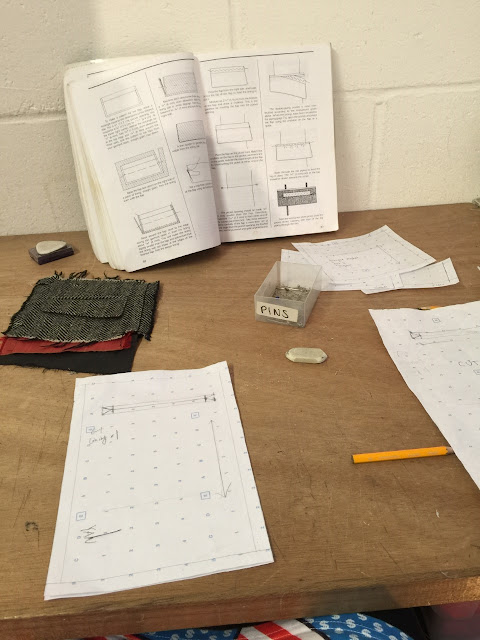I've been wanting to learn how to make a waistcoat for a while now, Ivor needed some new patterns for a client so it seemed like the perfect opportunity to learn and create a bespoke waistcoat for Ivor his client and myself. I started the process by doing a very basic rough sketch of the type of waistcoat I was going to make (shown in the image below).
I decided that the waistcoat would look, feel and sit better with two darts in the back and two in the front, but it is also a style choice, each waistcoat varies and there are no set rules.
I've been working on creating a bespoke double breasted waistcoat, but seeing as i'm no professional I'm still creating patterns using the measurements I have taken. I have added a few extra centimetres on the side and shoulder seams so that I have extra room just incase I need to take the waistcoat in slightly. Since it's a double breasted waistcoat I am adding quite a large facing to it, I have also decided to add jetted pockets to the front with a dart going through the pockets right to the centre of the waistcoat. The darts at the front and back give shape and allow the waistcoat to sit nicely on the body. I will be making a fully canvased waistcoat as this will last for years to come and they tend to age a lot better than a half canvased or interfaced garment. The canvas will mimic the front waistcoat patterns and will be fairly stiff and hopefully made out of horse hair to give more of a structured affect.
Once I felt happy with my patterns I decided to toile them using calico for the exterior and micro satin for the interior lining. I started off by cutting the fabric for the lining and facings and then stitching them together using a machine. The lining will be attached to the front of the waistcoat by hand instead of a machine, this gives it more of a luxury personal bespoke feel and I could have intact stitched all of it by hand but I felt that as I am still learning I will start off by using the machine. I have made sure to press all the darts towards the back and instead of pressing the seams open I have just let them sit in the direction they fall naturally so that when the garment is being worn you don't get any bulking or twisting from the seams allowing the waistcoat to sit and move naturally.
 |
| Finished Waistcoat Lining |

Half way through making the waistcoat Ivor and I started talking about what fabrics to use and I realised that I didn't really no much about fabrics. I wasn't really sure which fabrics would be best and which fabrics would go with each of the different types of canvases. Ivor said that all of this was personal and all depends on how structured you want the waistcoat, this confused me even more because how structured did I want the waistcoat? and how did I know if this would look good or work with the look I had in my head?
After confusing myself and being uncertain with where I wanted to go next with the waistcoat I started to look through some of Ivor's books and samples to see if this helped to clarify things for me slightly. Reading through the books and looking at the samples was actually very helpful because it made me realise that wool would be a very good choice for a waistcoat especially a double breasted waistcoat. I decided that tweed would be the best choice as it is nice and traditional and as a material has lots of good properties to it for example; it is very warm and resilient, and is very versatile and doesn't have to be used for just winter garments so I think this is a good place to start as far as fabrics are concerned.
Through looking at the samples and comparing the different thicknesses of fabrics to the different canvases it gave me a better idea of what I was looking for. I decided that as I like tweed and want to use this as my main fabric using a thicker canvas might give a nicer shape and make the waistcoat stand out and look quite structured and elegant.
And now the hunt begins for the perfect fabric.





































